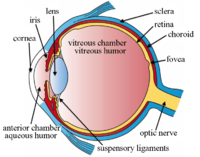
Photo from wikipedia
ATP activates P2X receptors and acts as a neurotransmitter in the nervous system. We have previously reported that P2X receptors modulate the firing rate of retinal ganglion cells. Since many… Click to show full abstract
ATP activates P2X receptors and acts as a neurotransmitter in the nervous system. We have previously reported that P2X receptors modulate the firing rate of retinal ganglion cells. Since many subtypes of P2X receptors are distributed in the mouse retina, it is likely that the modulatory effects of P2X receptor-mediated signaling can occur at multiple synaptic levels in the retina. In this study, we investigated whether P2X receptors expressed between the photoreceptor layer and the inner nuclear layer in the mouse retina were physiologically functional, by electroretinography (ERG). In the combined rod-cone ERG and the scotopic ERG, intravitreal injection of PPADS, an antagonist of P2X receptors, had no effects on the amplitude of the a-wave, but decreased the amplitude of the b-wave. In the photopic ERG, intravitreal injection of PPADS significantly decreased the amplitude of both the a-wave and the b-wave. In ex vivo recordings, a decrease in the b-wave amplitude was observed at 20μM PPADS, confirming that the inhibition of the b-wave by intravitreal injection of PPADS is due to the inhibition of P2X receptors. Our findings suggest that P2X receptor-mediated signaling has a physiological effect in both the rod and the cone pathways in postreceptoral processing.
Journal Title: Neuroscience Research
Year Published: 2017
Link to full text (if available)
Share on Social Media: Sign Up to like & get
recommendations!